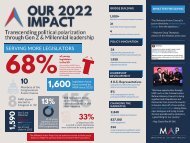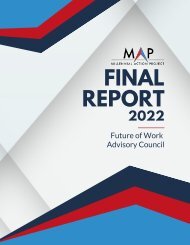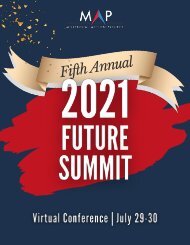Millennials on the Rise Report 2022
Create successful ePaper yourself
Turn your PDF publications into a flip-book with our unique Google optimized e-Paper software.
O N T H E R I S E<br />
T H E M O S T C O M P R E H E N S I V E D A T A<br />
O N Y O U N G P E O P L E R U N N I N G F O R<br />
C O N G R E S S I N 2 0 2 2<br />
NOVEMBER <strong>2022</strong>
Intro<br />
Candidate Count<br />
Millennial Incumbents<br />
INDEX<br />
About MAP<br />
Methodology<br />
Partisan Breakdown<br />
Gender Breakdown<br />
MAP's C<strong>on</strong>gressi<strong>on</strong>al<br />
Future Caucus<br />
<strong>2022</strong> Overview<br />
Geographic<br />
Why It Matters<br />
Distributi<strong>on</strong>
<str<strong>on</strong>g>Millennials</str<strong>on</strong>g> and Gen Zers are transforming our politics. In <strong>the</strong><br />
<strong>2022</strong> editi<strong>on</strong> of our <str<strong>on</strong>g>Millennials</str<strong>on</strong>g> <strong>on</strong> <strong>the</strong> <strong>Rise</strong> report, we tracked <strong>the</strong><br />
young people stepping forward to run for C<strong>on</strong>gress and bring<br />
generati<strong>on</strong>al change to Washingt<strong>on</strong>.<br />
At Millennial Acti<strong>on</strong> Project, we believe in <strong>the</strong> power of <strong>the</strong> next<br />
generati<strong>on</strong> to improve how our nati<strong>on</strong> governs. Our audacious<br />
missi<strong>on</strong> centers <strong>on</strong> activating young leaders to bridge <strong>the</strong><br />
partisan divide and transform American politics. The numbers in<br />
this report prove that change is already underway. With <strong>on</strong>e out<br />
of every six candidates for C<strong>on</strong>gress this cycle coming from <strong>the</strong><br />
millennial generati<strong>on</strong> - a 57% increase in <strong>the</strong> number of<br />
millennial candidates compared to 2020 - it's clear young<br />
Americans are running toward what needs to be fixed, not away<br />
from it.<br />
I N T R O<br />
<str<strong>on</strong>g>Millennials</str<strong>on</strong>g> <strong>on</strong> <strong>the</strong> <strong>Rise</strong> is an effort to better understand <strong>the</strong><br />
trends and demographics behind <strong>the</strong> rising generati<strong>on</strong> of leaders,<br />
because <strong>the</strong>se are <strong>the</strong> leaders who will shape our future.<br />
Sincerely,<br />
Layla Zaidane<br />
CEO & President of Millennial Acti<strong>on</strong> Project<br />
Layla Zaidane,<br />
MAP President & CEO
MILLENNIAL ACTION PROJECT<br />
Our Missi<strong>on</strong><br />
The Millennial Acti<strong>on</strong> Project has an audacious missi<strong>on</strong>:<br />
activate young leaders to bridge <strong>the</strong> partisan divide<br />
and transform American politics.<br />
Our Work<br />
The Millennial Acti<strong>on</strong> Project works directly with our<br />
nati<strong>on</strong>’s leading young policymakers <strong>on</strong> both a nati<strong>on</strong>al and<br />
state level to bridge <strong>the</strong> partisan divide and lead a new era<br />
of collaborative governance. As a nati<strong>on</strong>al, n<strong>on</strong>partisan<br />
n<strong>on</strong>profit dedicated to activating Millennial and Gen Z<br />
policymakers, MAP gives our nati<strong>on</strong>’s young leaders <strong>the</strong><br />
resources and support to develop and pass innovative<br />
policy soluti<strong>on</strong>s — and forge productive partnerships <strong>on</strong> <strong>the</strong><br />
issues affecting <strong>the</strong> youngest generati<strong>on</strong>s of Americans.
M E T H O D O L O G Y<br />
In assembling data for this report, lists of November 8,<br />
<strong>2022</strong> candidates were obtained from each<br />
State/Territory's Secretary of State website, or when not<br />
available from Ballotopedia. Write-in candidates and<br />
those deemed multiple decades older than 45 were<br />
eliminated from data collecti<strong>on</strong>. Ages were <strong>the</strong>n obtained<br />
from proprietary candidate surveys distributed by MAP as<br />
well as publicly available informati<strong>on</strong>: a combinati<strong>on</strong> of<br />
Wikipedia pages, campaign websites, news articles,<br />
social media profiles, and a Radaris search. When Radaris<br />
was used, all available informati<strong>on</strong> (e.g., current locati<strong>on</strong><br />
and locati<strong>on</strong> history, family members, educati<strong>on</strong>al<br />
history, etc.) was used to narrow down searches that<br />
yielded multiple people. Candidates for whom we could<br />
not c<strong>on</strong>fidently c<strong>on</strong>clude an age are not included in <strong>the</strong>se<br />
numbers.
2 0 2 2 E L E C T I O N S<br />
A T A G L A N C E<br />
GEN Z VOTERS<br />
MILLENNIAL VOTERS<br />
13.5% of <strong>the</strong> electorate<br />
27% of <strong>the</strong> electorate<br />
*Data source: Center for American Progress. Eligible Gen Z voters are an estimate based <strong>on</strong> 2020 and 2024 projecti<strong>on</strong>s.
Candidate Count<br />
334 193 91<br />
Age 45 or younger<br />
"True" <str<strong>on</strong>g>Millennials</str<strong>on</strong>g><br />
Age 35 or younger<br />
There are 334 candidates for <strong>the</strong> U.S. House and<br />
Senate who are age 45 or younger, <strong>the</strong> cutoff for<br />
membership in MAP's network. Sometimes<br />
referred to as "Xennials," lawmakers aged 42-45<br />
represent a shift towards youth political<br />
leadership in a world where <strong>the</strong> average age of<br />
<strong>the</strong> U.S. House is 59 years old.<br />
This report defines true millennials as a<br />
pers<strong>on</strong> born between 1981 and 1996.<br />
While <strong>the</strong>re is <strong>on</strong>ly a four year gap<br />
between candidates aged 45 and true<br />
millennials, this distincti<strong>on</strong> marks a<br />
disproporti<strong>on</strong>ate decrease. Of <strong>the</strong> 334<br />
total candidates, <strong>on</strong>ly 193 are true<br />
millennials.<br />
The 91 candidates under age 35 are<br />
made up of 89 true millennials and two<br />
Gen Z candidates. While people under<br />
age 35 represent 63% of <strong>the</strong> millennial<br />
generati<strong>on</strong>, <strong>on</strong>ly 46% of millennials<br />
running are under 35.<br />
Two Gen Z candidates are <strong>on</strong> <strong>the</strong> ballot for <strong>the</strong> first
Increase in Candidates<br />
Aged 45 and Under<br />
42%<br />
COMPARISON TO<br />
2020<br />
Increase in "True"<br />
Millennial Candidates<br />
From 2020 to <strong>2022</strong>, <strong>the</strong>re was a<br />
42% increase in candidates aged 45<br />
and under running for C<strong>on</strong>gress.<br />
This includes a 57% increase for<br />
true Millennial candidates (born<br />
between 1981 and 1996).<br />
57%
Of <strong>the</strong> candidates for <strong>the</strong> U.S. House and<br />
Senate in <strong>2022</strong>, approximately 27% are 45<br />
and under, 16% are <str<strong>on</strong>g>Millennials</str<strong>on</strong>g>, and 7.6% are<br />
35 and under.<br />
1 out of 6<br />
C<strong>on</strong>gressi<strong>on</strong>al candidates<br />
nati<strong>on</strong>wide are<br />
<str<strong>on</strong>g>Millennials</str<strong>on</strong>g>
PARTISAN<br />
BREAKDOWN<br />
Republicans<br />
36.8%<br />
Democrats<br />
39.3%<br />
Slightly more young people are running<br />
as Democrats than as Republicans.<br />
Of <strong>the</strong> 334 candidates running for<br />
C<strong>on</strong>gress who are 45 or younger, 131<br />
are Democrats, 123 are Republicans,<br />
46 are Libertarians, 20 are<br />
Independents or have no party<br />
preference, and 14 bel<strong>on</strong>g to ano<strong>the</strong>r<br />
party.<br />
Independents<br />
6%<br />
O<strong>the</strong>r Party<br />
4.2%<br />
Libertarians<br />
13.7%
GENDER BREAKDOWN<br />
30.8% 68.9%<br />
Women<br />
Men<br />
Of <strong>the</strong> 334 candidates running for C<strong>on</strong>gress age 45 or<br />
younger, 103 are women, 230 are men, and <strong>the</strong>re is <strong>on</strong>e n<strong>on</strong>binary<br />
candidate.<br />
In 2020, 41% of <strong>the</strong> candidates age 45 and under were<br />
women. In <strong>2022</strong>, that number has dipped to just under 31%.
GEOGRAPHIC<br />
DISTRIBUTION<br />
The states with <strong>the</strong> greatest<br />
number of young candidates<br />
include Florida, California, Texas,<br />
and New York.<br />
This heat map shows <strong>the</strong> quantity<br />
of candidates for <strong>the</strong> U.S. House<br />
and Senate under <strong>the</strong> age of 45.
State Candidates State Candidates<br />
Florida 28 Pennsylvania 9<br />
California 26 Tennessee 9<br />
Texas 24 Indiana 8<br />
New York 21 Oklahoma 8<br />
Colorado 15 Virginia 8<br />
GEOGRAPHIC<br />
DISTRIBUTION<br />
Louisiana 14 Alabama 7<br />
Michigan 12 Missouri 7<br />
Illinois 11 North Carolina 7<br />
This state-by-state breakdown<br />
shows <strong>the</strong> quantity of candidates<br />
for <strong>the</strong> U.S. House and Senate<br />
under <strong>the</strong> age of 45.<br />
New Jersey 11 Ariz<strong>on</strong>a 6<br />
Ohio 11 Georgia 6
State Candidates State Candidates State Candidates<br />
South Carolina 6 Utah 4 North Dakota 2<br />
Washingt<strong>on</strong> 6 Hawaii 3 West Virginia 2<br />
Maryland 5 Iowa 3 Wyoming 2<br />
Massachusetts 5 New Mexico 3 C<strong>on</strong>necticut 1<br />
Minnesota 5 Oreg<strong>on</strong> 3 Delaware 1<br />
Wisc<strong>on</strong>sin 5 Verm<strong>on</strong>t 3 Maine 1<br />
Arkansas 4 Alaska 2 Nevada 1<br />
Kansas 4 Idaho 2 South Dakota 1<br />
Kentucky 4 Mississippi 2 M<strong>on</strong>tana 0<br />
New<br />
Hampshire<br />
4 Nebraska 2 Rhode Island 0
Sen. J<strong>on</strong> Ossoff (GA) is <strong>the</strong> first<br />
"true" Millennial elected to serve in <strong>the</strong> U.S.<br />
Senate.<br />
MILLENNIAL<br />
INCUMBENTS<br />
There are 67 incumbents who are 45 or younger.<br />
Eight of <strong>the</strong>m decided not to seek re-electi<strong>on</strong>,<br />
and 4 were defeated in <strong>the</strong>ir primary. Three of<br />
<strong>the</strong> 67 incumbents are in <strong>the</strong> Senate - J<strong>on</strong><br />
Ossof (D-GA),<br />
Josh Hawley (R-MO), and Tom Cott<strong>on</strong> (R-AR)<br />
Of <strong>the</strong>se 67, <strong>the</strong>re are 33 incumbents who are<br />
true <str<strong>on</strong>g>Millennials</str<strong>on</strong>g>. Four decided not to seek reelecti<strong>on</strong>,<br />
and 3 lost <strong>the</strong>ir primaries, all of whom<br />
are 35 or younger.
Rep. Blake Moore (R-UT)<br />
C<strong>on</strong>gressi<strong>on</strong>al Future Caucus Co-<br />
Chair<br />
CONGRESSIONAL<br />
FUTURE CAUCUS<br />
Rep. Sara Jacobs (D-CA)<br />
C<strong>on</strong>gressi<strong>on</strong>al Future Caucus Co-<br />
Chair<br />
The C<strong>on</strong>gressi<strong>on</strong>al Future Caucus (CFC) is our nati<strong>on</strong>'s first and <strong>on</strong>ly<br />
bipartisan caucus for young members of C<strong>on</strong>gress.<br />
Members of <strong>the</strong> CFC come toge<strong>the</strong>r to identify and enact soluti<strong>on</strong>s to<br />
<strong>the</strong> problems facing America’s youngest generati<strong>on</strong>s. By c<strong>on</strong>vening<br />
across <strong>the</strong> aisle and dem<strong>on</strong>strating a new political c<strong>on</strong>sciousness,<br />
<strong>the</strong>se legislators are breaking <strong>the</strong> status-quo of hyper-partisanship<br />
and proving America’s next generati<strong>on</strong> leads differently.
WHY IT<br />
MATTERS<br />
Young legislators are redefining how<br />
America governs.<br />
Younger legislators are leading <strong>the</strong> charge in finding comm<strong>on</strong> ground in <strong>the</strong> halls of C<strong>on</strong>gress.<br />
Members of <strong>the</strong> Millennial Acti<strong>on</strong> Project’s C<strong>on</strong>gressi<strong>on</strong>al Future Caucus stand out as some of<br />
<strong>the</strong> most collaborative members of C<strong>on</strong>gress when it comes to working across <strong>the</strong> aisle,<br />
according to <strong>the</strong> Lugar Center's most recent 2021 Bipartisan Index scores.<br />
Despite comm<strong>on</strong> misc<strong>on</strong>cepti<strong>on</strong>s about <strong>the</strong> partisanship of rising generati<strong>on</strong>s, Members 45<br />
years old or younger have been scored as more bipartisan than <strong>the</strong>ir older peers for <strong>the</strong> last<br />
three C<strong>on</strong>gresses in a row. Both Republicans and Democrats in this cohort score above <strong>the</strong><br />
historical average for bipartisanship. As more young people join C<strong>on</strong>gress, our country can<br />
anticipate leaders who are willing to work collaboratively to solve our most pressing<br />
problems.















